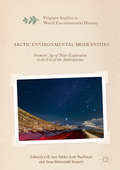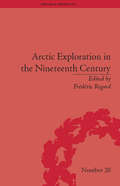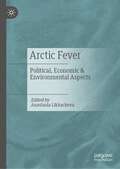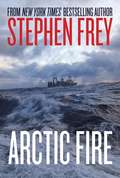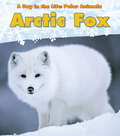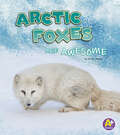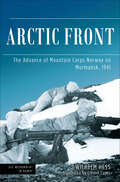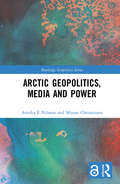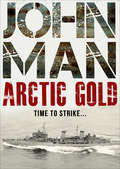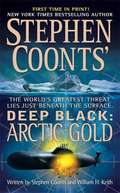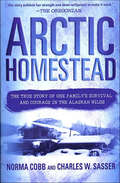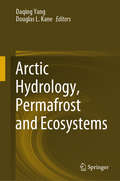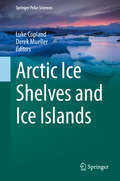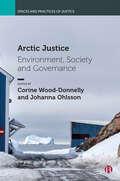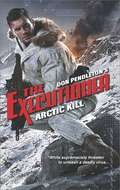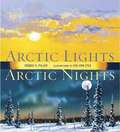- Table View
- List View
Arctic Environmental Modernities: From the Age of Polar Exploration to the Era of the Anthropocene (Palgrave Studies in World Environmental History)
by Lill-Ann Körber Anna Westerståhl Stenport Scott MacKenzieThis book offers a diverse and groundbreaking account of the intersections between modernities and environments in the circumpolar global North, foregrounding the Arctic as a critical space of modernity, where the past, present, and future of the planet’s environmental and political systems are projected and imagined. Investigating the Arctic region as a privileged site of modernity, this book articulates the globally significant, but often overlooked, junctures between environmentalism and sustainability, indigenous epistemologies and scientific rhetoric, and decolonization strategies and governmentality. With international expertise made easily accessible, readers can observe and understand the rise and conflicted status of Arctic modernities, from the nineteenth century polar explorer era to the present day of anthropogenic climate change.
Arctic Euphoria and International High North Politics
by Geir HønnelandThis pivot describes the ups and downs of Norwegian High North politics since the end of the Cold War. It considers how political interest in the Arctic has been growing rapidly in the international community as states stake their claim to areas of the continental shelf in the Arctic Ocean, and focuses on Russia’s actions, as the Arctic state with the longest shoreline and the only one outside NATO. The author argues that among the Western countries, Norway has the most extensive experience in tackling Russia in the Arctic, and the neighbourhood with the Russian Bear invariably shapes foreign policy, notably in matters of security, and how foreign policy concerns are intertwined with economic motives, be that hopes of access to the big Russian market or to the oil and gas fields on the Russian Arctic shelf. To achieve the combined goal of security and business, the Norwegian Government has regularly orchestrated “Arctic waves” to direct the attention of local, national and international politicians and businesses to the alleged opportunities of the North. In this book, the author takes us through “the Great Barents Awakening” of the 1990s, “the Great High North Enchantment” of the early 2000s and recent years’ “Arctic wave” in Norwegian foreign policy.
Arctic Exploration in the Nineteenth Century: Discovering the Northwest Passage (Empires in Perspective)
by Frédéric RegardFocusing on nineteenth-century attempts to locate the northwest passage, the essays in this volume present this quest as a central element of British culture.
Arctic Fever: Political, Economic & Environmental Aspects
by Anastasia LikhachevaThis book explores the Arctic as a rapidly evolving phenomenon in international affairs of a rising number of stakeholders. For decades, Arctic studies used to be an affair of a relatively narrow group of experts from northern countries. This time is over due to a new Chinese Arctic policy, as well as growing regional interests from South Korea, Singapore, India and Japan. Contributors reflect on new roles for the Arctic region: both as a playground for the old school nation state competition and even confrontation, and a new source for international cooperation in energy, logistics and natural sciences. Climate change, political tensions and economic competition make Arctic a hotter venue of international relations. This new Arctic fever, studied through a comparative analysis of different regional agendas, especially with a focus on the US–China–Russia triangle, represents the main subject of our book, which will be of interest to scholars of geopolitics, of climate change, and of 21st century energy economics.
Arctic Fire
by Stephen W. FreyTroy Jensen could do it all: he conquered the Seven Summits, sailed solo around the world twice, and even fought a bull in a Mexican slum on a dare. So when word comes that a rogue wave has swept Troy off a crab fishing boat in the Bering Sea and into a watery grave, his brother, Jack, doesn't buy it. Against his better judgment, Jack decides to quit his job as a Wall Street trader and head to Dutch Harbor, Alaska, to investigate. Minutes after revealing his plan in his father's New York City office, Jack is nearly run down in the street. He doesn't think much of it at the time, but as he digs deeper into Troy's disappearance, Jack unearths information about RED-CELL-SEVEN (RCS), a super-secret American intelligence group that has operated for forty years in almost total secrecy and with complete impunity--and its leaders intend to keep it that way at any cost. An adrenaline-pumping tale of one man's descent into a hellish underworld populated by terrorists, assassins, and very bad "good guys," Arctic Fire explores the disturbing difference between doing what is good and doing what is right when it comes to protecting America from her greatest enemies.
Arctic Fox
by Katie MarsicoFollow an arctic fox through its day as it eats, sleeps, and cares for its young.
Arctic Fox Pups (Wild Baby Animals)
by Ruth OwenArctic fox pups grow up in one of the coldest places on Earth. When they are very small, their parents bring food to them. As they grow, however, their parents teach them how to hunt and find their own food. Look inside to discover all the ways these wild baby animals get ready to become grown-up arctic foxes.
Arctic Fox: Clever Hunter / Fennec Fox: Desert Survivor (Fountas & Pinnell Classroom, Guided Reading)
by Sara Latta Alice McGintyNIMAC-sourced textbook
Arctic Foxes Are Awesome (Polar Animals Ser.)
by Jaclyn JaycoxWhat’s that springing into the air? An Arctic fox! He lands, breaking through the snow. He has caught his lunch. Learn more about Arctic foxes and how they survive in the frigid tundra. Follow them as they search for prey beneath the snow and ice. Find out how fox pups stay safe from roaming predators.
Arctic Freeze (Race the Wild #3)
by Kristin EarhartOn a once-in-a-lifetime race through the animal kingdom, it takes smarts, strength, and skill to win!The air might be freezing, but the race is heating up! Dev can't stop thinking about how much he'd disappointed his dad by signing up for The Wild Life. But to win a race through the frozen Arctic tundra, where animals are ferocious and nature is extreme, the red team needs everyone to give it their all...even Dev! And if he doesn't, his new friends may be giving him the cold shoulder...Each chapter in this action-packed adventure series is bursting with totally true facts about wild and wonderful creatures, dangerous habitats, maps, and more!
Arctic Front: Defending Canada in the Far North
by P. Whitney Lackenbauer Ken S. Coates William R. Morrion Greg PoelzerA hard-hitting, timely, and provocative book about the history and future of the Canadian Arctic. With passion and sharp words, Arctic Front confronts Canada’s longstanding neglect of the Far North and outline what needs to be done to protect our national interest. Through a lively and engaging history of the region, Arctic Front reveals how Canadians and their governments have:ignored this region for generationsexpanded Canadian sovereignty over the past hundred years by reacting to other countries’ challengesbecome the least effective of all Circumpolar nations in responding to the needs of the Arcticneglected our obligations to the North, including a failure to capitalize on the human and economic resources of this vast land or to establish a presence that would make any foreign claims to offshore resources inconceivable.As global warming continues to melt the ice in the Northwest Passage and the competition for northern resources heats up, Canada, the authors warn, will be forced to defend this area from a position of grave weakness. Our leaders need to take action today, blending defence and development, to complete Canadian nation building in this fragile region. An energetic and engaging collaboration by four of Canada’s leading Northern specialists, Arctic Front is a clarion call to all Canadians about our endangered Arctic region, challenging the country to step away from the symbols and myth making of the past and toward the urgent political, environmental and economic realities of the 21st century.
Arctic Front: The Advance of Mountain Corps Norway on Murmansk, 1941 (Die Wehrmacht im Kampf)
by Wilhelm Hess“A very thorough analysis as to why and how the combined German-Finnish army . . . ultimately failed in their quest to seize Murmansk during Barbarossa.” —Globe at WarIn 1941, military operations were conducted by large formations along the northern coast of Scandinavia—for the first time in the history of warfare. The Arctic Front was the northernmost theater in the war waged by Germany against Russia. For a period of four years, German troops from all branches of the Wehrmacht fought side by side with Finnish border guard units.The high point of the war on the Arctic Front was the assembly and advance of Germany’s Mountain Corps Norway in the summer and autumn of 1941. Commanded by general of the mountain troops, Eduard Dietl, and composed of the 2nd and 3rd Mountain Divisions, the Mountain Corps advanced out of occupied North Norway, assembled in the Petsamo Corridor in North Finland, and struck into Russian territory in an attempt to seize Murmansk. It did not reach its objective. This account of the operation was written by Wilhelm Hess, quartermaster of the Mountain Corps Norway. He draws upon his personal experience of the conditions and actions on the Arctic Front in order to describe and analyze the environment, the sequence of events, and the reasons behind certain decisions. In addition to describing how operations conducted by the Mountain Corps unfolded, Hess provides insight as to how the terrain, the flow of supplies, and the war at sea impacted those operations.“A serious, thoughtful book about war . . . in conditions hardly conducive to survival, let alone combat.” —Stone & Stone
Arctic Geopolitics, Media and Power (Routledge Geopolitics Series)
by Miyase Christensen Annika Nilsson E.Arctic Geopolitics, Media and Power provides a fresh way of looking at the potential and limitations of regional international governance in the Arctic region. Far-reaching impacts of climate change, its wealth of resources and potential for new commercial activities have placed the Arctic region into the political limelight. In an era of rapid environmental change, the Arctic provides a complex and challenging case of geopolitical interplay. Based on analyses of how actors from within and outside the Arctic region assert their interests and how such discourses travel in the media, this book scrutinizes the social and material contexts within which new imaginaries, spatial constructs and scalar preferences emerge. It places ground-breaking attention to shifting media landscapes as a critical component of the social, environmental and technological change. It also reflects on the fundamental dilemmas inherent in democratic decision making at a time when an urgent need for addressing climate change is challenged by conflicting interests and growing geopolitical tensions. This book will be of great interest to geography academics, media and communication studies and students focusing on policy, climate change and geopolitics, as well as policy-makers and NGOs working within the environmental sector or with the Arctic region.
Arctic Gold
by John ManA man searches for the sunken treasure he once protected as a sailor in WWII in this “thrilling action story” from the acclaimed historian (Tom Kasey, author of Trade Off). Murmansk, Russia, 1942. The HMS Edinburgh is sailing deep in Russian territory, a bulwark against Nazi invaders. Among the eight-hundred-strong crew is Mike Cox, a sixteen-year-old boy from the East End, London who is about to be thrown into the heat of war. A Russian ship approaches the Edinburgh with a very precious cargo—over a thousand tons of gold—as payment from the Soviet Union for the Royal Navy’s protection. Now the English ship is tasked with safeguarding a fortune as well as the Barents Sea. But when a German U-boat fires torpedoes at the Edinburgh’s hull, the crew must fight for their lives . . . and Mike is one of only a few survivors to escape from the wreck as the gold sinks eight hundred feet to the bottom of the sea. After making his way back to London, Mike finds himself more alone than ever. He starts training to become a diver with one objective in mind: to rescue that precious Arctic gold. But he’ll have to act quick—he’s not the only one looking for it . . .
Arctic Gold (Deep Black #7)
by Stephen Coonts William H. KeithIn the Arctic, two American intelligence operatives are kidnapped while investigating Russian submarines—a constant, covert presence beneath the ice caps. In Washington, ex-Marine Charlie Dean and his team at Desk Three trace the abduction back to the Russian mafiya, who have their sights set on the massive reserves of oil that lie thousands of feet below the ocean's floor. While Dean is sent to the Arctic to rescue the hostages, the beautiful Lia DeFrancesca penetrates a heavily guarded dacha on the shores of the Black Sea. There she learns the explosive truth about Russia and its Arctic oil—one that could cost Dean and his Deep Blackteam their lives...and drive the world's superpowers to the brink of war.
Arctic Governance Through Conferencing: Actors, Agendas and Arenas (Frontiers in International Relations)
by Beate SteinvegThis book examines the functions of conferences within Arctic governance, as a third dimension between sovereign states and formalized cooperative arrangements. It analyzes conferences against the background of three main empirical topics. Firstly, the functions of conferences for different actor groups, both Arctic rights holders and emerging non-Arctic state actors claiming stakeholder status. From this, the book also analyzes how conferences contribute to altering the actor composition of Arctic governance as a whole. Secondly, conferences as agenda setting arenas – whether conference activities can contribute to influencing the broader agenda in the region, and conferences as arenas for agenda setting – whether participants can bring with them topics that are picked up and brought into other processes. Thirdly, the book considers the space for conferences within broader governance architectures, as links between units in the regime complex.The book further presents an in-depth case study of the two largest conferences on Arctic issues: the Arctic Frontiers and Arctic Circle Assembly. It illustrates the diverse functions conferences can have for elements within a broader governance system, beyond serving as meeting places and networking arenas. Therefore, it is a must-read for researchers, students, and policy-makers interested in a better understanding of Arctic governance in particular, and International Relations in general.
Arctic Heat: A Forced Proximity LGBTQ Romance (Frozen Hearts)
by Annabeth AlbertA lasting connection needs more than simply surviving a winter together—they&’ll have to outsmart danger, let down their defenses and open their hearts.&“Whether making my heart melt or my head burst into flames, Annabeth Albert draws the reader in and keeps them captivated.&” —Gay Book ReviewsOwenI&’ve got a fresh lease on life—after kicking cancer&’s ass I&’m roaring through my bucket list. I left my life as an investment banker behind hoping to find my next challenge in Alaska, volunteering alongside park rangers and fulfilling my childhood dreams of snowy winters and rustic life. Of course, those dreams did tend to feature big strapping mountain men in vivid detail… men like Ranger Quilleran Ramsey.As the snowbound weeks pass and we give in to temptation, I can&’t help but wonder if our seasonal romance can last until spring?QuillI&’d rather be anywhere than dealing with newbie volunteers. The only thing I need less than a green volunteer &“partner&” is the flirty attentions of Owen Han, the buff city boy who doesn&’t look ready to last a week, let alone a whole Alaskan winter. We&’re all wrong for each other, if only my traitorous body didn&’t enjoy the flirting more than it should.We&’ll have to trust each other to ensure the harsh elements and omnipresent dangers don&’t destroy what happiness we&’ve found in the moment, and maybe even give us a chance at a future together.Previously published Frozen Hearts Book 1: Arctic Sun Book 2: Arctic Wild Book 3: Arctic HeatAlso by Annabeth Albert:Shore Leave Book 1: Sailor Proof Book 2: Sink or SwimOut of Uniform Book 1: Off Base Book 2: At Attention Book 3: On Point Book 4: Wheels Up Book 5: Squared Away Book 6: Tight Quarters Book 7: Rough Terrain
Arctic Heat: A Gay Romance (Frozen Hearts #3)
by Annabeth AlbertA lasting connection needs more than simply surviving a winter together—they’ll have to outsmart danger, let down their defenses and open their hearts.Owen Han has a fresh lease on life—he’s kicked cancer’s ass and is roaring through his bucket list. The former investment banker hopes to find his next challenge in Alaska, volunteering alongside park rangers and fulfilling his childhood dreams of snowy winters and rustic life. Of course, those dreams did tend to feature big strapping mountain men in vivid detail…Ranger Quilleran Ramsey would like to be anywhere other than dealing with newbie volunteers. And really, the only thing he needs less than a green volunteer “partner” is the flirty attentions of a buff city boy who doesn’t look ready to last a week, let alone an Alaskan winter. They’re all wrong for each other, even if Quill’s traitorous body enjoys the flirting more than it should.As the weeks pass, the two snowbound men give in to temptation. But can their seasonal romance last until spring? For them to have a future together, each will have to trust the other…while hoping that the harsh elements and omnipresent dangers don’t destroy what happiness they’ve found in the moment.One-click with confidence. This title is part of the Carina Press Romance Promise: all the romance you’re looking for with an HEA/HFN. It’s a promise!This book is approximately 89,000 words
Arctic Homestead: The True Story of One Family's Survival and Courage in the Alaskan Wilds
by Charles W. Sasser Norma Cobb“A memoir as wild, engaging, stubborn, and authentic as that distant valley where [Cobb’s] family staked out the last plot in America.” —John Balzar, author of Yukon AloneIn 1973, Norma Cobb, her husband Lester and their five children—the oldest of whom was nine years old and the youngest, twins, barely one—pulled up stakes in the lower 48 and headed north to Alaska to follow a pioneer dream of claiming land under the Homestead Act. The only land available lay north of Fairbanks near the Arctic Circle where grizzlies outnumbered humans twenty to one. In addition to fierce winters and predatory animals, the Alaskan frontier drew the more unsavory elements of society’s fringes. From the beginning, the Cobbs found themselves pitted in a life or death feud with unscrupulous neighbors who would rob from new settlers, attempt to burn them out, shoot them and jump their claim.The Cobbs were chechakos, tenderfeet, in a lost land that consumed even toughened settlers. Everything, including their “civilized” past, conspired to defeat them. They constructed a cabin—and first snow collapsed the roof. They built too near the creek and spring breakup threatened to flood them out. Bears prowled the nearby woods, stalking the children and Lester Cobb would leave for months at a time in search of work.But through it all, they survived on the strength of Norma Cobb—a woman whose love for her family knew no bounds and whose courage in the face of mortal danger is an inspiration to us all. Arctic Homestead is her story.“Her story exhibits her strength and sheer willpower to make it work.” —Oregonian
Arctic Hydrology, Permafrost and Ecosystems
by Daqing Yang Douglas L. KaneThis book provides a comprehensive, up-to-date assessment of the key terrestrial components of the Arctic system, i.e., its hydrology, permafrost, and ecology, drawing on the latest research results from across the circumpolar regions. The Arctic is an integrated system, the elements of which are closely linked by the atmosphere, ocean, and land. Using an integrated system approach, the book’s 30 chapters, written by a diverse team of leading scholars, carefully examine Arctic climate variability/change, large river hydrology, lakes and wetlands, snow cover and ice processes, permafrost characteristics, vegetation/landscape changes, and the future trajectory of Arctic system evolution. The discussions cover the fundamental features of and processes in the Arctic system, with a special focus on critical knowledge gaps, i.e., the interactions and feedbacks between water, permafrost, and ecosystem, such as snow pack and permafrost changes and their impacts on basin hydrology and ecology, river flow, geochemistry, and energy fluxes to the Arctic Ocean, and the structure and function of the Arctic ecosystem in response to past/future changes in climate, hydrology, and permafrost conditions. Given its scope, the book offers a valuable resource for researchers, graduate students, environmentalists, managers, and administrators who are concerned with the northern environment and resources.
Arctic Ice Shelves and Ice Islands (Springer Polar Sciences)
by Luke Copland Derek MuellerThis book provides an overview of the current state of knowledge of Arctic ice shelves, ice islands and related features. Ice shelves are permanent areas of ice which float on the ocean surface while attached to the coast, and typically occur in very cold environments where perennial sea ice builds up to great thickness, and/or where glaciers flow off the land and are preserved on the ocean surface. These landscape features are relatively poorly studied in the Arctic, yet they are potentially highly sensitive indicators of climate change because they respond to changes in atmospheric, oceanic and glaciological conditions. Recent fracturing and breakup events of ice shelves in the Canadian High Arctic have attracted significant scientific and public attention, and produced large ice islands which may pose a risk to Arctic shipping and offshore infrastructure. Much has been published about Antarctic ice shelves, but to date there has not been a dedicated book about Arctic ice shelves or ice islands. This book fills that gap.
Arctic Justice: Environment, Society and Governance
by Corine Wood-Donnelly and Johanna OhlssonEPDF and EPUB available Open Access under CC-BY-NC-ND licence. Offering a unique introduction to the study of justice in the European, North American and Russian Arctic, this collection considers the responsibilities and failures of justice for environment and society in the region. Inspired by key thinkers in justice, this book highlights the real and practical consequences of postcolonial legacies, climate change and the regions’ incorporation into the international political economy. The chapters feature liberal, cosmopolitan, feminist, as well as critical justice perspectives from experts with decades of research experience in the Arctic. Moving from a critique of current failures, the collection champions a just and sustainable future for Arctic development and governance.
Arctic Kill
by Don PendletonDORMANT DEATH Formed in the wake of World War I, a renegade secret society has never lost sight of its goal to eradicate the "lesser races" and restore a mythical paradise. This nightmare scenario becomes a terrifying possibility when the society discovers an ancient virus hidden in a Cold War-era military installation. Called in to avert the looming apocalypse, Mack Bolan must stop the white supremacists by any means necessary. Bolan tracks the group to Alaska, enduring the harsh arctic conditions while dodging highly trained killers. But the clock is ticking down, and Bolan will need all his skills and resourcefulness to eliminate this threat. All that stands between millions of people and a sure death is one man. The Executioner.
Arctic Landscapes and Traditions 3-Book Bundle: Ukkusiksalik / Uvajuq / Thelon
by David F. PellyFrom an explorer of the North's cultural landscape, comes the stories and history of remote corners of our North. David F. Pelly gives a rare in-depth account of Inuit history based on oral testimony and historical records. Includes: Ukkusiksalik: The People's Story Ukkusiksalik, now a national park, was in earlier times the principal hunting ground for several Inuit families and was criss-crossed by missionaries, Mounties, and traders. David F. Pelly presents the stories of Inuit elders and historical records to provide a complete history of this extraordinary corner of our northern landscape. Uvajuq: The Origin of Death The Inuit story of Uvajuq (oo-va-yook) is rooted in a time when people and animals lived in such harmony and unity that they could speak to each other. The legend of Uvajuq, as told here, was collected from a group of Inuit elders in the Nunavut community of Cambridge Bay, 300 kilometres north of the Arctic Circle. Thelon: A River Sanctuary David Pelly tells the story of the Thelon, exploring the mystery of humankind's relationship with this special place in the heart of Canada's vast Arctic Barren Lands.
Arctic Lights, Arctic Nights
by Debbie S. MillerThe book describes the unique light phenomena of the Alaskan Arctic and the way animals adapt to the temperature and daylight changes each month of the year.
